Located at 122 East Peachtree Street, the building housing the Locker Plant (ground floor) and Masonic hall (2nd floor) was built in 1916. The two-story, painted-brick building features a stepped cornice, Masonic emblem centered on second floor, and double-leaf entrance flanked by shutters and carriage lights. There are double-hung windows on both the second floor and ground floor.
The building was built as the original location of Dr. Hugh Boyd’s (1880-1932) office. David Bradford, whose family owned the building for many years, had been told this fact by his father. It is confirmed in the article about Dr. Hugh Boyd in The Heritage of Jackson County, Alabama. Dr. Boyd graduated from Memphis Medical College in May 1899 and in November of that year went into practice with his brother, Dr. Andrew Boyd. He suffered an injury to his arm in 1904, being dragged for some distance by as scared horse as he was getting out of his buggy. “In 1918 Hugh Boyd was commissioned as a lieutenant in a base hospital organized at Memphis for overseas service. He opened his office over First national Bank. He built a new office on South side of the square.” The architecture report states the building was constructed in 1916, so the dates to not fit precisely. The article states that Lynch was a Mason and buried with Masonic honors. The Masonic symbol appears on the front of this building, and for many years was the meeting place of the Scottsboro Masons.
Jimmy Thompson recalls that after Dr. Boyd’s death, Dr. Marvin Lynch practiced in this building for a time. The Lynch Building was built 1939-40.
This building was modified heavily to add refrigeration infrastructure before it opened as the Locker Plant business in 1944. In the late 1970s, the Locker Plant became Old Hickory Food and Chemicals and provided industrial cleaning and food preparation supplies and pool testing and chemicals. Around 2000, Bill Bradford sold the building to Safety First Services, whose owner, Hank Moghani, modified it substantially to meet his needs and merged it with the annex next door.
Throughout the history of this building, the Masonic Lodges were always located upstairs. In the 1966 city directory, the occupants of this space are referred to as “Lodge #359 F & A M.” By 1970 the Masons must have built a new facility because this space is listed as vacant. By 1975, this space was occupied by the Fraternal Order of Police. They were in this space through the early 1990s.
Current view: Safety First Services
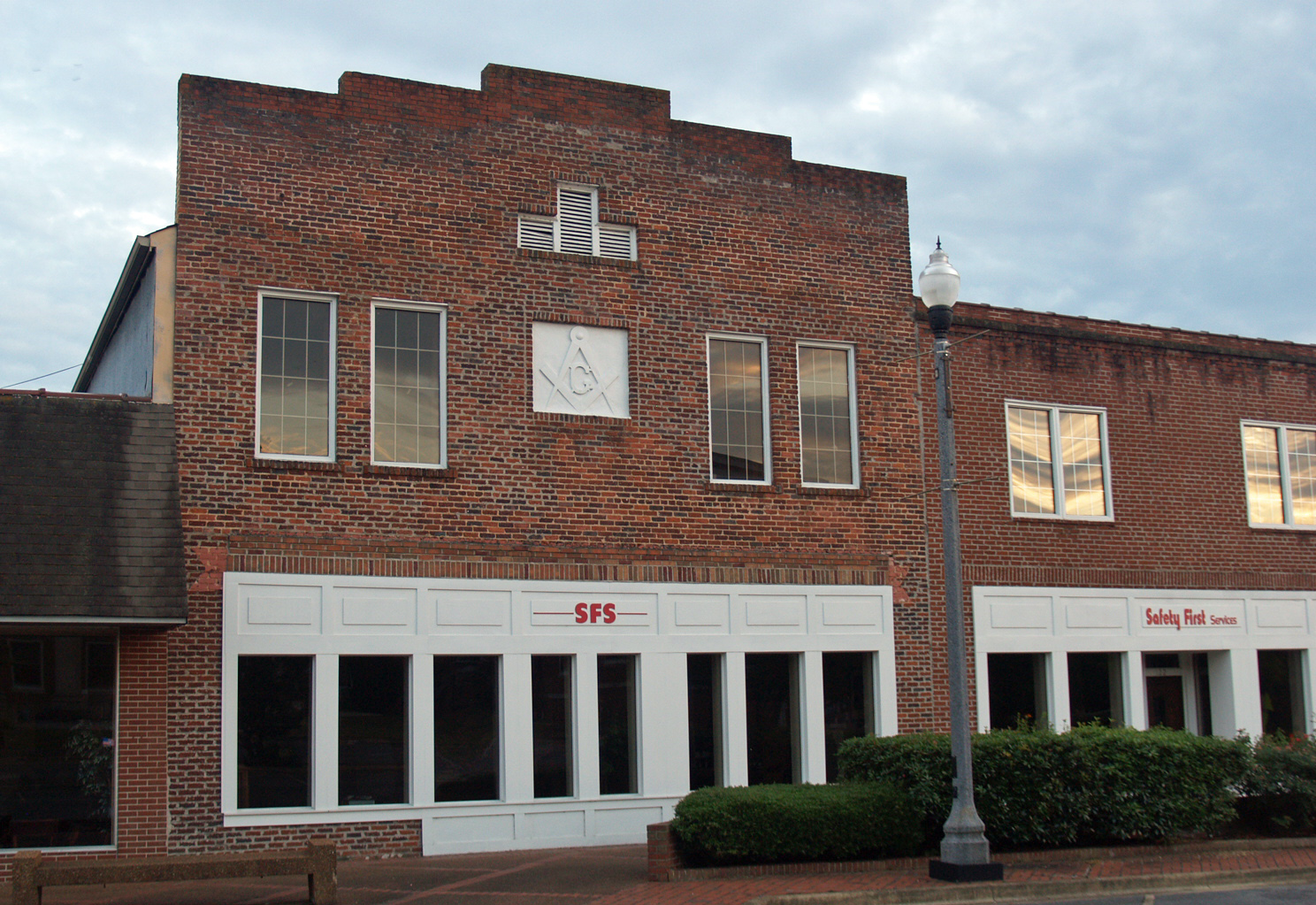
1930s WPA photograph from the Alabama Archives
Here is a photo of the front of the building, taken by WPA photographers in the 1930s, from the Alabama State Archives.
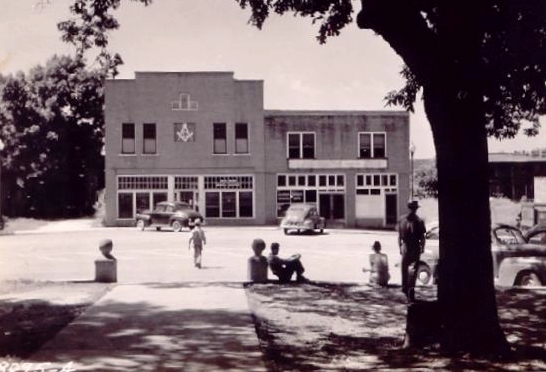
Late 1960s: First Monday photo showing Old Hickory Smokehouse
This First Monday photo from the late 1960s show Old Hickory Smokehouse in this elongation, along with the Thrifty Mart and the Moon Light Cafe.
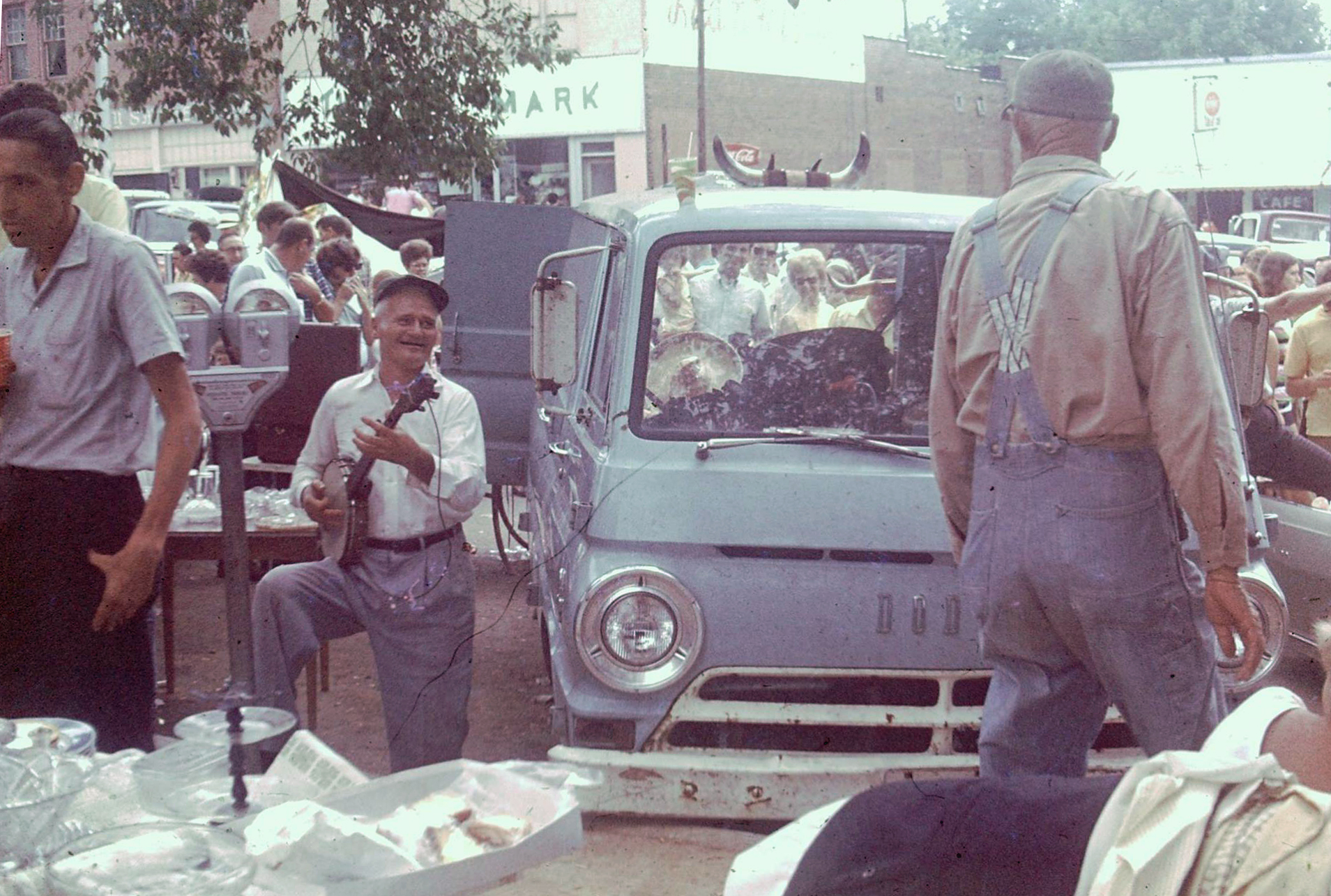
David Bradford’s JCHA article on the Locker Plant
David Bradford wrote about the Locker Plant for the Jackson County Chronicles. David Bradford is the son of William Washington (Bill) Bradford and Bettye (Hall) Bradford. David’s maternal grandfather was Jewell Hall and his Maternal great-grandfather was John B. Benson, the two local business entrepreneurs who founded The Locker Plant in 1942.:
Most Jackson County homes built the 18th and 19th centuries had smokehouses. I spent my first years playing in a smokehouse behind our home on the corner of Larkin and Kyle Streets. The dirt floor and the rough-hewn walls were black from the hickory and oak that had smoldered for decades in the fire pit. Had it occurred to me to taste the dirt, I would have tasted salt. I’ve read that during the Civil War, the dirt from families’ smokehouse floors were percolated to extract brine.
Preservation of meat by “curing” it was a difficult, time-consuming, and error-prone task for early settlers. Curing preserves meat allowing it to be preserved at ambient temperatures. Curing entails drawing as much moisture as possible out of meat and, more importantly. out of the microorganisms that populate it. When enough water is drawn from the virulent bacteria, the cell dies and can no longer replicate.But there’s an added advantage to the dehydration process: curing changes the texture and the taste of meat. As meat loses water, its flavor is concentrated, and salt-tolerant bacteria that remain contribute additional flavors and tenderness through fermentation.
Packing meat in salt was the earliest from of curing. Then, in the 1600’s, the process was significantly enhanced when it was discovered that the addition of saltpeter (nitrate) was effective in staving off the last remaining and most tenacious of pathogens: botulism. Settlers and provisioners also understood that slow-roasting in a smokehouse accelerated the dehydration process since smoking adds chemicals to the surface of meat that reduce the concentration of salt required and seals the outer layer of meat, making it more difficult for bacteria to enter.But the consequences of mistakes in the curing/smoking process were dire: food poisoning was a constant threat to the mortality of families.
From the beginning, there were commercial solutions: Matthew Washington, who moved to Jackson County in the 1840’s, had been schooled in the Smithfield process of curing hams before coming here. He marketed his hams from his farm and from shops in Bellefonte and Stevenson.
Ironically, even Matthew’s professionally prepared hams proved deadly in a round-a-bout way: The 59-year-old Matthew died of exhaustion trying to hide them from advancing federal troops in 1862.
Some 90 years after Matthew died, the first high-tech solution to food preservation became generally available: freezing.
Earlier in the twentieth century, refrigeration was accomplished by placing a block of ice in an insulated wooden cabinet. In 1918, Frigidaire introduced the first electric refrigerator. But while these appliances maintained food for short periods, they could not preserve it from harvest to harvest. As late as the 1950’s, home freezers built into refrigerators lacked the capacity to preserve a family’s yearly provisions.
So there was a stir in 1944 when The Jackson County Locker Plant opened on the south side of the courthouse square in Scottsboro. The Progressive Age called it “one of the largest and possibly the most modern in the entire country.” The article also noted that “To many, a locker plant is more or less a mystery, because it is something new in this area, and you are invited to visit the place and you will learn a lot of how much good modern inventions can do, not only in war time, but in the peace times to come.”<.p>
The Locker Plant, co-owned by John Benson and Jewell Hall, was based on a business model introduced in the early years of WWII that called for community centers that offered rental lockers to those who wanted to preserve foods using the new technology. For a rental fee of $12 a year, a customer could have the use of drawer-type metal locker of about 12 square feet capacity in a vault-like room kept at a steady five degrees below zero.
A customer who entered with his key would pass behind a meat counter (stocked with bacon, baloney, cheese, and sausage offered for public sale) to enter a room of approximately 1800 square feet often permeated by fog induced by the frigid air and hung with stalactites of ice. The storage room was cooled by massive flywheel-driven compressors that used ammonia as a refrigerant. Those who worked at the facility were able to tolerate the ammonia that constantly leaked from the compressors without so much as a watery eye, but the public had to be protected from the irritating chemical by sealed doors.
The freezer infrastructure was technically complex and expensive. The owners acknowledged that the freezer facility cost “thousands” and they were hampered by engineering problems involved in trying to alter the old building at 122 East Peachtree to its new purpose. Originally slated to open in May, 1944, the facility finally celebrated its open house in August of that year.
Canning had proved for decades an economical way of preserving fruits and vegetables, requiring only a modest outlay in materials and equipment to accomplish. With an accepted procedure for preserving crops. the primary application of the new freezer technology was to preserve meat. Still, The Locker Plant hosted Home Demonstration Agents and TVA Home Economists, inviting them to hold workshops at The Locker Plant, instructing homemakers on what fruits and vegetables were best suited for freezing and how they ought to be prepared. The plant also bought red peppers and sage to produce the plant’s unique “old fashioned” sausage seasoning.
In pursuit of the more lucrative meat market, The Locker Plant also offered off-the-truck meat processing services. Cattle and hogs were staged in the stockyards backing onto Appletree Street and moved through a series of processing rooms that culminated in a preparation room where the various cuts were packaged in waxed butcher paper and moved to the locker facilities for quick freeze. The fee for processing pork was one cent per pound dressed weight. For three cents a pound, a portion of the animal could be processed as sausage.
For those who favored the old preservation methods, the plant also offered curing (via the more modern injected brine process, not the traditional dry-brine process) and an on-site smokehouse (a massive metal cabinet with a firebox at its base). Customers who continued to rely on curing apparently felt secure that their provisions were stable since the plant ran ads imploring their customers “whose processed or cured meat is ready to take home to come and get it at once as we are badly in need of space for more of this needed work.”
Most children of the era will remember that the left half of the building was given over to the “Dairy King,” where James Paradise drew soft-serve ice cream and dispensed it from a half- moon window onto Peachtree Street. The Dairy King closed around 1960.
By the late 1960’s, the agrarian nature of the county was changing, and The Locker Plant adapted. Complaints about the smell of the stockyards resulted the slaughter business being phased out. Home chest-type freezers, which became available through local appliance dealers in the mid-1950s, ended the need for community freezers.Accordingly, The Locker Plant diversified, moving into the restaurant supply business in the 1970’s. The locker infrastructure was dismantled. Many of the metal lockers were recycled as troughs for feeding livestock.
The resultant business was renamed the “Old Hickory Smokehouse,” an acknowledgment of the only part of The Locker Plant’s original mission that was retained past the 1970s: smoking and curing meats.
Ironically, the owner of the business that led this transition during the 1970’s was William Washington Bradford. Bill was the great grandson of Matthew Washington, who had literally died for his hams 130 years before.
1957 aerial view showing Locker Plant stock pens
This aerial photo taken in 1957 shows this white frame building between Armstrong Cleaners and the Lad’n Lassie that was known as Bertha’s Moonlight Cafe. Notice the stock pens behind the Locker Plant.

1945 photos of the Locker Plant opening
Here are photos of the Locker Plant after its opening in 1945. The first photo is from the Benson family. The remaining photos are from the Alabama Archive.

People working at the Locker Plant when it opened in 1945. L to R, Unknown, Unknown, Bill Bradford, John David Hall, John Benson, Joan Hall, Jewell Hall, unknown, unknown, unknown, unknown. The Cocker Spaniel was named Benny.
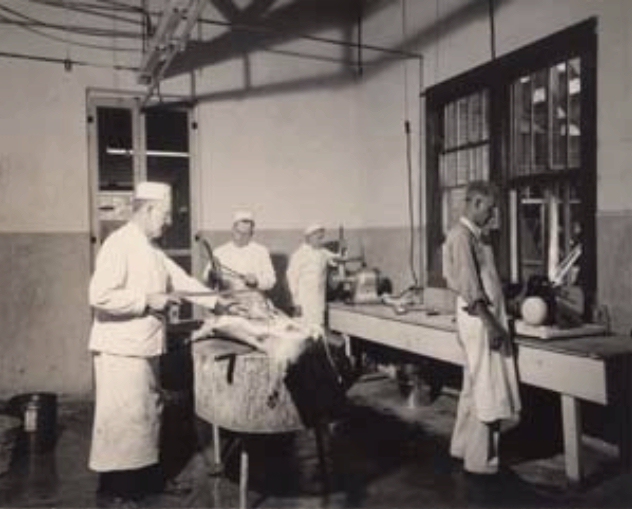
Slicing and grinding meeting in the cutting room at the locker plant in Scottsboro, Alabama.
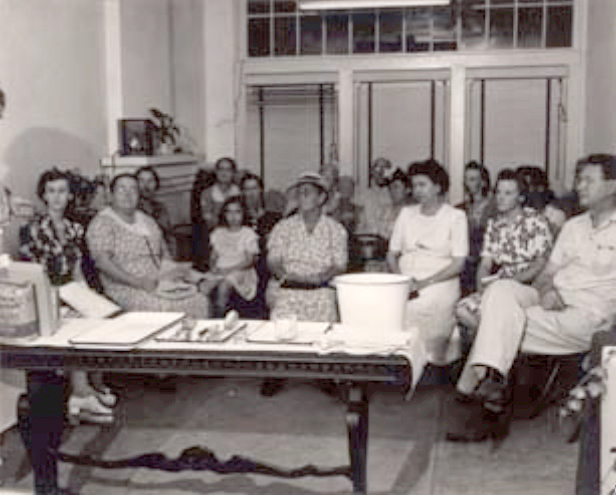
Demonstration of the processes and products of the locker plant in Scottsboro, Alabama. Women in the photo are unidentified, but the sole male on the right is Jewell Hall.

John David Hall putting a tray of packaged vegetables into the quick-freezer at the locker plant in Scottsboro, Alabama.
Locker Plant receipt from the Barbee family

Locker Plant and Dairy King Ads, 1945 Progressive Age

